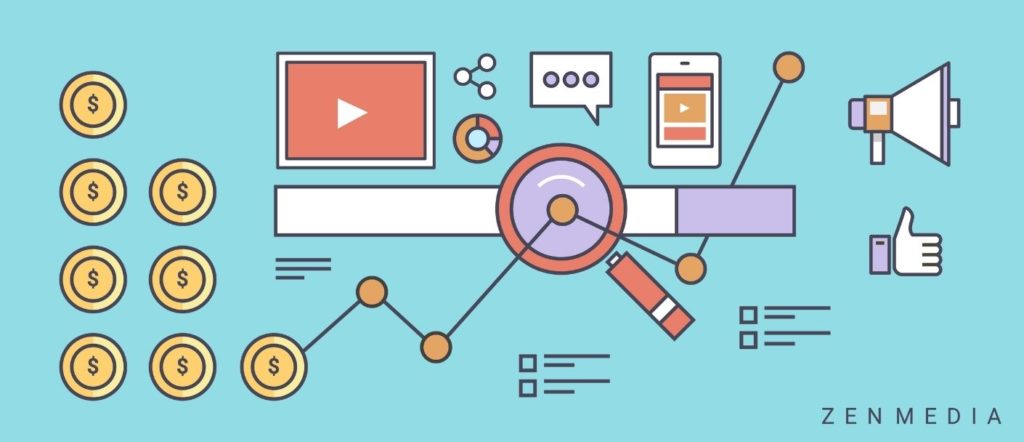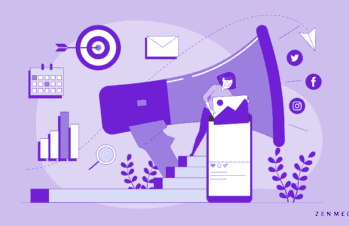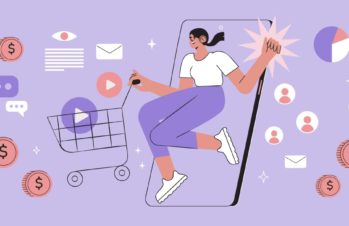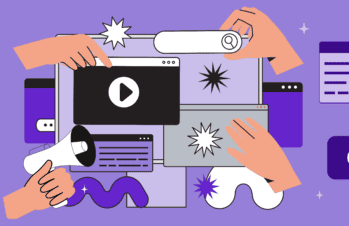Imagine a world where every brand could rely on putting out great content and just letting customers organically find their way to you—without spending a dime on paid ads.
Unfortunately, that’s not the reality we’re living in.
The truth is, no matter how great your brand’s products and services may be, there’s simply too much content online to guarantee anyone will find your brand, let alone become a customer. So, what can you do when you’re competing with millions of other pieces of content and thousands of other brands at any given moment?
Implement B2B paid advertising.
Let’s take a closer look at how paid ads can benefit your B2B company.
What is B2B paid advertising?
B2B paid advertising is a form of B2B marketing where businesses use paid ads to attract potential customers. The main goal of B2B paid advertising is to get potential buyers to engage with your business and reach out to prospects who are interested in buying from your business.
B2B paid advertising includes display advertising such as banner ads, search ads, pop-ups, and interstitials, and video advertisements. The main difference between B2C and B2B paid advertising is that B2B paid advertising typically aims to reach specific audiences rather than general audiences.
What can B2B paid advertising do for your brand?
Here’s a brief rundown of some of the benefits of B2B paid advertising:
- Ensure your content reaches the greatest number of targeted people possible
- Increase conversions
- Increase engagements
- Increase awareness
- Boost sales
- Boost lead generation
When it’s paired with other marketing tactics like social media, content, and B2B PR, B2B paid advertising can give your brand the push it needs to reach your audience and the top of your industry.
How do you measure the success of B2B paid advertising?
B2B paid advertising has become one of the most effective ways for businesses to reach potential customers. The key to measuring the effectiveness of any campaign is to track conversions. Conversion tracking allows you to determine which campaigns are working best and what changes need to be made to future campaigns.
You should also be tracking the ROI of your B2B paid advertising campaign. If you want to know what works for your business, you need to find out which B2B paid ad campaigns generate the highest return on investment. This means finding out which ones convert into sales.
Why does your B2B brand need paid advertising?
As mentioned above, even if your brand is a household name like Xerox or IBM, it can’t compete with the amount of other industry content available based on organic reach alone. It just won’t happen.
Remember that when you’re online, you’re not only competing with other businesses in your niche—you’re up against businesses in every industry.
In fact, the next time you’re feeling unsure about committing budget dollars to B2B paid advertising, consider how much of your competition’s ad budget is allocated to paid advertising. Currently, B2Bs are expected to spend $37.7 billion on paid ads in 2024.
Most of this activity will happen on social media sites and mobile platforms. In fact, social media ad spend accounts for 28.8% of all digital advertising dollars and is estimated to reach $219.8 billion in 2024, growing 3.86% to reach $255.8 billion in ad spending generated through mobile by 2028. Much of this will be directed toward the U.S. market.
As the social platform of choice for B2Bs, LinkedIn should be a top target for marketers. With 89% of marketers using the professional networking site for lead generation, 62% of B2B marketers said it produces leads for them, coming in at a cost per lead that is 28% lower than Google Ads.
Paid ads on LinkedIn—and social media in general—are just one major way for brands to stay at the top of their industries.
Let’s take a closer look at the additional benefits brands can expect from B2B paid advertising online.
B2B paid advertising lets you increase your exposure on SERPs
The B2B purchasing process begins with brand awareness. Buyers then move through a seemingly infinite loop of exploration and evaluation, gathering information from websites, social media, search engines, and dark social shares to make purchasing decisions. This all happens in the messy middle, or what we at Zen Media call the “Dark Social Model.” While it may seem frustrating for brands to keep up with buyers, the model provides brands with opportunities to reach buyers through paid, earned, owned, and rented media.
Consider the buying journey for a new boutique fitness studio. Just starting to make a name for itself with customers in the area, the studio is spending a lot of time on in-person services and networking opportunities to increase membership. As the studio grows, it has to securely manage personal and financial data from clients and trainers, process payroll, and follow up with potential new clients. The problem? There isn’t enough room in the studio’s budget to fill any IT or accounting roles.
Instead, they start searching for service providers who can protect sensitive data, monitor potential threats, maintain operations, manage payments, send automated emails, and perform additional tasks as necessary. The studio then begins their buyer journey, turning to Google to search for a solution.
This is why Google search results (or SERPs, search engine results pages) matter so much. Your brand needs to show up near the top, ideally within the first five sites, when your prospects search for a relevant keyword.
You can continue to climb through the search rankings with B2B SEO strategies, but investing in a paid advertising strategy ensures that your prospects see your brand, even if you haven’t broken through to that first page of results yet. When people search a keyword that you’ve targeted with your ad, that ad will pop up on the sidebar and, hopefully, get you more site traffic, demo sign-ups, newsletter sign-ups, purchases, and so on.
And before you know it, the fitness studio will be reaching out, inquiring about your services and engaging with your brand to customize a plan that works for them.
B2B paid ads help you achieve concrete conversion goals
One key principle with B2B paid advertising is to tightly focus each ad (or ad set) on one single conversion action that you want customers to take.
For example:
- Downloading an ebook
- Visiting your new product page
- Signing up for a demo
- Following you on social
Ads work best when they lead users exactly where you want them to go. So, if the ad copy reads, “Download our latest report,” the user who clicks on it should be taken directly to a dedicated landing page where they can provide their email address and download the report—not to your full site (although you should include a link to your full site for those who want to explore more).
By choosing specific actions you want people to take, you can create groups of ads that help you reach each of those goals.
For example, let’s say we want people to sign up for a demo of our new product.
The first step would be to create a landing page for the demo sign-up. The landing page is where we’ll direct users when they click on our ad.
Pro tip: Set up an A/B test using two versions of the same landing page. Send users to one or the other with your ad. Then, you can compare the conversion rates for each landing page to see which one performed better and use the results to inform future design choices.
Once your landing page is designed and live, it’s time to focus on your paid advertising strategy. We’re going to start by laying out the goal and creating three different ads that will help us reach it.
Related post: 4 Critical Tips for Getting the Most Out of Paid Social Ads
Goal: Get demo sign-ups.
The first thing to do is identify the keywords that you’re going to target. Use a tool like Semrush or Keyword Planner from Google to help with this. You’re looking for keywords that are highly relevant yet also mid-range in volume.
Why?
Because the higher the search volume for a keyword (like “B2B SAAS demos”), the more it will cost you per click. Additionally, higher-volume keywords can either become so general that they don’t move the needle or so expensive that it doesn’t make sense to spend the budget on them, considering how intense your competition for those clicks will be.
So, instead of choosing “B2B SAAS demos” as your keyword, you could choose “best B2B SAAS demo for mid-size companies,” or “affordable B2B SAAS demo,” or some other variation that fits your product and matches what your audience is searching for.
Related post: The Ultimate Guide to Creating a Search Engine Marketing Strategy
Ideally, you’ll create a few different B2B paid ads for one goal, so you can see which digital campaign works best and maximize your reach.
Once you have those ads running, whether simultaneously or one at a time, you’ll be able to see which is performing best.
B2B paid advertising strategies for 2024
B2B marketing has changed drastically in the past few years, and it’s still evolving. What strategies should you be using to reap the benefits of paid media in 2024?
With more companies relying on digital solutions to reach B2B buyers, B2B paid advertising is an important tool for all sizes of business. Traditional tactics, like print or radio ads, are no longer effective as consumers have become conditioned to ignore these. Today’s marketers need to think more strategically about modern B2B paid advertising strategies in order to be successful.
The Impacts of Generative AI and Social Media Algorithms on Paid Ads
Emerging technology must be factored into B2B paid advertising strategies. Over the past year, the rise of generative AI and shifting algorithms on social media have dramatically altered marketing and advertising behaviors—and B2Bs should take note.
Google’s Focus on AI
Revealing the company’s plans for generative AI and advertising during this year’s Google Marketing Live and Google I/O events, the company shared it would roll out several features designed to help advertisers create and enhance ads. Google also announced it is testing and figuring out how to run ads alongside its latest launch, AI Overviews, an evolving search feature that provides summaries and links to sources in response to users’ queries.
And because Google sets industry trends, B2Bs should keep an eye on responses from other search engines and consumers. While it’s too soon to see just how competitors will respond, data reveals more and more consumers are beginning their search journeys on sites like Amazon or apps like YouTube and TikTok. Additionally, the launch of AI Overviews was met with searches and tutorials for “how to turn off AI Overviews,” as well as articles against the feature, indicating not all users are aligned with this shift in search.
There’s no doubt search is changing. Remain flexible in your paid ad strategy to accommodate different platforms and user preferences throughout these changes.
Now Trending: Short-form Videos
Short-form video content is taking over feeds, causing 33% of marketers to prioritize this type of content over any other social media strategy.
The following results from Wyzowl’s Video Marketing Statistics 2024 report reveal video’s impact on businesses overall:
- 90% of marketers report good ROI from video marketing and indicate video has increased brand awareness
- 87% report video has helped generate leads
- 69% of marketers spend money on video ads, while the remaining 31% rely on organic reach
- 90% of video marketing happens on YouTube, followed by Facebook (86%), Instagram (79%), and LinkedIn (76%)
- 89% of consumers want brands to create more videos in 2024
- 82% of consumers were convinced to buy a product or service after watching a video
Short-form video yields the best results and provides the highest ROI. While Gen Z is leading the charge in favoring short-form video, the format is increasingly popular across more age groups. In fact, Instagram Reels and YouTube Shorts have emerged as competitors to TikTok, taking on similar formats in their efforts to reach more users.
Essentially, businesses leveraging video see strong results and form better connections with their target audiences by prioritizing more engaging and creative content to enhance the user experience.
Adapting in an Era of Constant Change
As you plan your paid ad and digital marketing strategy for the rest of the year, be sure your business goals reflect the current patterns of your customer’s journey. Not only will this help you determine where to invest your resources, it will show your audience you’re listening.
Consider the following questions when forming your campaign goals: Where are B2B audiences finding product reviews? How can your brand deliver relevant content to your target markets? Where should you focus your advertising and marketing efforts?
Conduct frequent audits and be prepared to pivot strategies when necessary; flexibility will go a long way in creating long-term business success. And as technology continues to evolve rapidly and changes occur within the marketplace, new strategies will emerge to help businesses capitalize on their target audience through paid B2B advertising campaigns.
To stay ahead of the competition and maximize returns in 2024, here are the top two B2B paid advertising strategies that marketers should be aware of:
1. Leverage first-party data for the most refined and accurate retargeting audience.
First-party data is extremely valuable for running effective ad campaigns because it offers insights directly from a brand’s customers. This data includes behavioral patterns and other types of user interactions with the brand, such as website visits and purchases. These insights can be used to create personalized marketing strategies that will help target more relevant audiences, increase campaign effectiveness and ROI, optimize ad creative and messaging, and improve customer satisfaction. Use AI to gather this information, create reports based on the data, and automate tasks where possible.
2. Utilize multiple channels to earn more exposure and keep your brand in front of your target audience.
Running B2B paid ads on multiple platforms allows you to reach a wide variety of audiences and ensure your message is seen by the people who need it. This also allows you to target customers in specific locations or customer segments, as each platform has its own targeting features. Additionally, running ads on different platforms helps you build an effective multi-channel marketing strategy and track which channels deliver the most conversions, giving you valuable data for optimization. Test TikTok, amplify your presence on LinkedIn, and optimize content for generative AI search results.
The importance of paid advertising for B2B brands
It’s easy to see how important advertising is for B2C, especially since customers can sometimes complete the entire purchasing journey after seeing just a couple of ads on social media.
That’s not the case for B2B, but ads are still just as critical.
For one thing, they can shorten the sales cycle. Research shows that it takes prospects at least 8 interactions with a brand before customers take any action to buy. That number is likely higher, given that so many interactions are now happening on dark social and other areas where they can’t be known or tracked.
If three or four of those interactions happen when a prospective customer sees your B2B paid ads, you’ve already shortened your sales cycle.
If you’re trying to increase engagement on social, B2B paid advertising can be a great way to funnel more prospects and customers to your social channels. And, of course, ads that are both highly targeted and closely focused on a single action can go a long way toward boosting your qualified lead generation.
Related post: B2B Marketing Budgets: Benefits of Branding over Lead Gen Campaigns
Ready to get started? Let our SEMs help.




